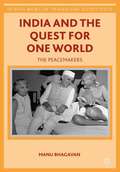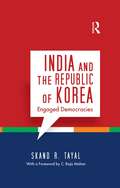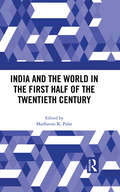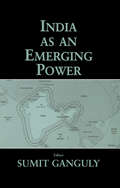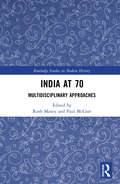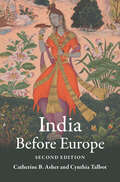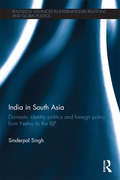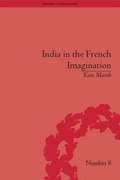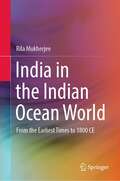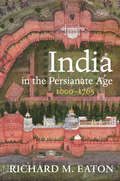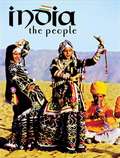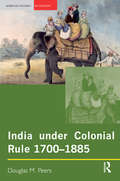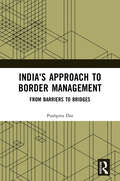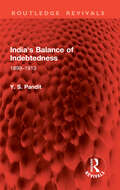- Table View
- List View
India and the Quest for One World
by Manu BhagavanIndia and the Quest for One World revolutionizes the history of human rights, with dramatic impact on some of the most contentious debates of our time, by capturing the exceptional efforts of Mahatma Gandhi and the Nehrus to counter the divisions of the Cold War with an uplifting new vision of justice built on the principle of "unity in diversity. "
India and the Republic of Korea: Engaged Democracies
by Skand R. TayalExamining the underlying logic of the strategic and economic partnership between the Republic of Korea and India, this book is the first detailed study of the numerous facets — cultural, economic, people-to-people, and strategic — of blossoming relations between two major Asian democracies. This comprehensive survey documents the interaction between the two governments, relying on facts and hitherto unpublished original records provided by India’s Ministry of External Affairs; offers an illuminating account of India’s active role as a neutral party in the post-Second World War events of the Korean War and the division of the Korean Peninsula; and provides a vision of the future direction of India–Korea relations. The author also shares candid observations of Korean society and its people during his service as Ambassador of India in Seoul. The work will be useful to policy makers as well as students of politics and international relations, strategic studies, economics, and contemporary world history.
India and the Responsibility to Protect: Negotiating Democratic Postcolonial And Great Power Identities (Rethinking Asia and International Relations)
by Alan BloomfieldBloomfield charts India’s profoundly ambiguous engagement with the thorny problem of protecting vulnerable persons from atrocities without fatally undermining the sovereign state system, a matter which is now substantially shaped by debates about the responsibility to protect (R2P) norm. Books about India’s evolving role in world affairs and about R2P have proliferated recently, but this is the first to draw these two debates together. It examines India’s historical responses to humanitarian crises, starting with the 1971 Bangladesh Liberation War, concentrating on the years 2011 and 2012 when India sat on the UN Security Council. Three serious humanitarian crises broke during its tenure - in Côte d'Ivoire, Libya and Syria - which collectively sparked a ferocious debate within India. The book examines what became largely a battle over ’what sort of actor’ modern India is, or should be, to determine how this contest shaped both India’s responses to these humanitarian tragedies and also the wider debates about rising India’s international identity. The book’s findings also have important (and largely negative) implications for the broader effort to make R2P a recognised and actionable international norm.
India and the World in the First Half of the Twentieth Century
by Madhavan K. PalatThis book examines how India was placed and placed itself in the world during the first half of the 20th century in a period of global turmoil and set against the subcontinental contest for independence. In situating India in the world, it looks not just at current foreign policy studies, but also at geopolitics, World War experiences, theoretical and strategic approaches, early foreign policy institutional transitions and the role of Indian civil and foreign diplomatic services. The work explores history and theory with a focus on cosmopolitanism beyond nationalism. The use of extensive sources from archives in UK and Russia — especially in different languages, mainly German and Russian — lends this volume an edge over most other works. The book will be useful to professional academics, historians including military historians, security specialists, literary specialists, foreign policy experts, journalists and the general reader interested in international issues.
India and the World: A History of Connections, c. 1750–2000
by Claude MarkovitsIn this pioneering history of modern India, Claude Markovits offers a new interpretation of events of world importance, focusing on the multiplicity of connections between India and the world. Beginning with an examination of India's evolving role in the world economy, he deals successively with the movement of people out of and into India, the role played by Indian soldiers in a series of conflicts from the mid-eighteenth to the late twentieth century, the place of India in the global circulation of ideas and cultural productions and the relationships established between Indians and others both abroad and at home. Challenging dominant state-centred histories by focusing on the lived experiences of people, Markovits demonstrates that the multiple connections established between India and other lands did not necessarily result in mutual knowledge, but were often marked by misunderstanding.
India as an Emerging Power
by Sumit GangulyThese essays examine India's relations with key powers including the Russian Federation, China and the USA and with key adversaries in the global arena in the aftermath of the Cold War. One positive relationship is that of India's relations with Israel since 1992.
India at 70: Multidisciplinary Approaches (Routledge Studies in Modern History)
by Ruth Maxey Paul McGarrIndia at 70: Multidisciplinary Approaches examines Indian independence in August 1947 and its multiple afterlives. With nine contributions by a range of international scholars, it interrogates 1947 and its complex, bloody aftermath in historical, political and aesthetic terms. This original collection conceives of Indian independence in bold and innovative ways by moving across national boundaries and disciplinary, geopolitical and linguistic landscapes; and by examining a wealth of under-researched primary material, both recent and historical. India at 70 is a unique and indispensable contribution to Indian history, literary and cultural studies.
India before Europe
by Catherine B. Asher Cynthia TalbotIndia is a land of enormous diversity. Cross-cultural influences are everywhere in evidence, in the food people eat, the clothes they wear, and in the places they worship. This was ever the case, and at no time more so than in the India that existed from c. 1200 to 1750, before European intervention. In this thoughtfully revised and updated second edition, readers are taken on a richly illustrated journey across the political, economic, religious, and cultural landscapes of India – from the Ghurid conquest and the Delhi Sultanate, through the rise and fall of the southern kingdom of Vijayanagara and their successors, to the peripheries of empire, to the great court of the Mughals. This was a time of conquest and consolidation, when Muslims and Hindus came together to create a literary, material, and visual culture which was uniquely their own and which still resonates today.
India en tus labios (Trilogía de Oriente #Volumen 2)
by Isabel JennerLos labios de Ban evocan besos apasionados y susurros tan llenos de tentaciones como las cálidas noches de la India. Los labios de Leonelle Ingram dibujan sonrisas tan inusuales y deslumbrantes como los legendarios tesoros que guarda esa extraordinaria tierra del trópico. Él, un brahmán apenas aceptado por la sociedad británica del Raj, ha jurado que jamás revelará sus secretos a la única mujer capaz de atenuar un dolor que lo destroza por dentro, y cuya perspicacia pone en riesgo todo por lo que ha luchado durante años. Ella, quien ya siente que la India se ha convertido en su hogar más que el propio Londres del que partió meses atrás, ha prometido que descubrirá la verdad acerca del único hombre que ha conseguido distraerla de sus libros y estudios para despertar emociones a las que no consigue poner nombre, pero que la hacen sentirse atrapada y libre a la vez.¿Alguno de los dos logrará cumplir su palabra sin resultar herido? ¿Seguirán enfrentándose en cada oportunidad o se convertirán en inesperados aliados que luchan contra un magnetismo tan imparable y demoledor como el monzón que arrasa con todo a su paso?
India from Latin America: Peripherization, Statebuilding, and Demand-Led Growth
by Manuel GonzaloThis book studies the economic history of India and traces the Indian path of development from a Latin American framework and perspective. Despite sharing many historical and geological similarities, dialogue between the young democracies of Latin America and the Indian subcontinent is still extremely scarce. The volume builds a common research agenda for the economic development of the Global South. It offers Latin American insights and highlights novelties and commonalities the region shares with India’s economic development. It pays special attention to the (geo)political, technological, financial, and institutional aspects related to the specific geographical and demographical features of the Indian subcontinent. A step towards strengthening the dialogue on economic development in the Global South, this book will be of interest to scholars and researchers of heterodox economics, Indian economy, comparative economics, macroeconomics, political economy, economic history, development studies, Latin American studies, and South Asian studies.
India in South Asia: Domestic Identity Politics and Foreign Policy from Nehru to the BJP (Routledge Advances in International Relations and Global Politics)
by Sinderpal SinghSouth Asia is one of the most volatile regions of the world, and India’s complex democratic political system impinges on its relations with its South Asian neighbours. Focusing on this relationship, this book explores the extent to which domestic politics affect a country’s foreign policy. The book argues that particular continuities and disjunctures in Indian foreign policy are linked to the way in which Indian elites articulated Indian identity in response to the needs of domestic politics. The manner in which these state elites conceive India’s region and regional role depends on their need to stay in tune with domestic identity politics. Such exigencies have important implications for Indian foreign policy in South Asia. Analysing India’s foreign policy through the lens of competing domestic visions at three different historical eras in India’s independent history, the book provides a framework for studying India’s developing nationhood on the basis of these idea(s) of ‘India’. This approach allows for a deeper and a more nuanced interpretation of the motives for India’s foreign policy choices than the traditional realist or neo-liberal framework, and provides a useful contribution to South Asian Studies, Politics and International Studies.
India in the Fifteenth Century: Being a Collection of Narratives of Voyages to India in the Century preceding the Portuguese Discovery of the Cape of Good Hope; from Latin, Persian, Russian, and Italian Sources, now first Translated into English (Hakluyt Society, First Series)
by R. H. MajorThe volume contains the following accounts, edited, with an introduction: Narrative of the voyage of Abd-er-Razzak, Ambassador from Shah Rukh, A.H. 845, A.D. 1442.; The travels of Nicolò Conti in the East in the early part of the fifteenth century; The travels of Athanasius Nikitin, a native of Twer; The journey of Hieronimo di Santo Stefano, a Genoese. This is a new print-on-demand hardback edition of the volume first published in 1857.
India in the French Imagination: Peripheral Voices, 1754-1815 (Empires in Perspective #8)
by Kate MarshExamines metropolitan French-language representations of India from the period between the recall of Dupleix to France to the Second Treaty of Paris. This book explores what a European power, territorially peripheral in India, thought of both India and the administrative rule there of its rival, Britain.
India in the Indian Ocean World: From the Earliest Times to 1800 CE
by Rila MukherjeeThe book integrates the latest scholarly literature on the entire Indian Ocean region, from East Africa to China. Issues such as India's history, India’s changing status in the region, and India's cross-cultural networking over a long period are explored in this book. It is organized in specific themes in thirteen chapters. It incorporates a wealth of research on India’s strategic significance in the Indian Ocean arena throughout history. It enriches the reader's understanding of the emergence of the Indian Ocean basin as a global arena for cross-cultural networking and nation-building. It discusses issues of trade and commerce, the circulation of ideas, peoples and objects, and social and religious themes, focusing on Hinduism, Buddhism, and Islam. The book provides a refreshingly different survey of India’s connected history in the Indian Ocean region starting from the archaeological record and ending with the coming of empire. The author’s unique experience, combined with an engaging writing style, makes the book highly readable. The book contributes to the field of global history and is of great interest to researchers, policymakers, teachers, and students across the fields of political, cultural, and economic history and strategic studies.
India in the Italian Renaissance: Visions of a Contemporary Pagan World 1300-1600
by Meera JuncuIndia in the Italian Renaissance provides a systematic, chronological survey of early Italian representations of India and Indians from the late medieval period to the end of the 16th century, and their resonance within the cultural context of Renaissance Italy. The study focuses in particular on Italian attitudes towards the inhabitants of the Indian subcontinent and questions how Renaissance Italians, schooled in the admiration of classical antiquity, responded to the challenge of this contemporary pagan world. Meera Juncu draws from a wide-ranging selection of contemporary travel literature to trace the development of Italian ideas about Indians both before and after Vasco Da Gama’s landing in Calicut. After an introduction to the key concepts and a survey of inherited notions about India, the works of a diverse range of writers and editors, including Marco Polo, Petrarch and Giovanni Battista Ramusio, are analysed in detail. Through its discussion of these texts, this book examines whether ‘India’ came in any way to represent a pagan civilization comparable to the classical antiquity celebrated in Italy during the Renaissance. India in the Italian Renaissance offers a new and exciting perspective on this fascinating period for students and scholars of the Italian Renaissance and the history of India.
India in the Persianate Age: 1000–1765
by Richard M. EatonProtected by vast mountains and seas, the Indian subcontinent might seem a nearly complete and self-contained world with its own religions, philosophies, and social systems. And yet this ancient land and its varied societies experienced prolonged and intense interaction with the peoples and cultures of East and Southeast Asia, Europe, Africa, and especially Central Asia and the Iranian plateau. Richard M. Eaton tells this extraordinary story with relish and originality, as he traces the rise of Persianate culture, a many-faceted transregional world connected by ever-widening networks across much of Asia. Introduced to India in the eleventh century by dynasties based in eastern Afghanistan, this culture would become progressively indigenized in the time of the great Mughals (sixteenth, seventeenth, and eighteenth centuries). Eaton brilliantly elaborates the complex encounter between India's Sanskrit culture—an equally rich and transregional complex that continued to flourish and grow throughout this period—and Persian culture, which helped shape the Delhi Sultanate, the Mughal Empire, and a host of regional states. This long-term process of cultural interaction is profoundly reflected in the languages, literatures, cuisines, attires, religions, styles of rulership and warfare, science, art, music, and architecture—and more—of South Asia.
India in the World: 1500 to the Present (Routledge Studies in Modern History)
by Nico Slate Rajeshwari DuttIf we look back at world history in the past five hundred years, it is evident that Indian ideas, peoples, and goods helped drive world connections. From the quest to reach the Indies that drove Iberian rulers to fund costly expeditions that ultimately connected the Old World with the Americas to Gandhi’s creed of non-violence that created transnational resistance movements, India has been crucial to world history. In what ways have the movement of goods, people, and ideas from India served to connect the world? Conversely, how has India’s global history shaped the many boundaries and inequalities that have divided the world despite—and at times because of—the transnational connections often lumped together under the aegis of globalization? Through its emphasis on both linkages and boundaries, India in the World examines the range of connections between India and the world in a truly global perspective.
India of My Dreams
by M. K. GandhiIt is a happy idea to place before the world and the country at the present moment when we are entering upon a new era a picture of the India of Mahatma Gandhi’s dreams. The freedom which we have won is throwing upon us the responsibilities of making or marring the future of India. It is in no small measure the achievement of Mahatma Gandhi’s leadership. The matchless weapon of truth and non-violence which he has used is needed by the world to cure it of many of its ills. In our hour of victory and rejoicings we cannot afford to ignore either the leader who has led us or the undying principles which have inspired him. Freedom is only the means to a greater and nobler end, and the achievement of India of Mahatma Gandhi’s dreams will be the fitting consummation of all that he has worked for and stands for. A book, which places before the reader not only those basic and fundamental principles, but also indicates how we can help to fulfil them through our freedom by establishing a polity and social life, and through the instrumentality of a constitution and the dedication of the human material which this vast country will now throw up to work without any external fetters or internal inhibitions. — Rajendra Prasad
India the Land (Lands, Peoples, and Cultures)
by Bobbie KalmanUpdated facts and statistics highlight this new second revised edition of India the Land. Spectacular photographs feature India's varied geography from snow-covered mountaintops to tropical rainforests. Learn about India's major cities, its disputed borders, foreign influences, and current challenges
India the People (Revised Edition, The Lands, Peoples, and Cultures Series)
by Bobbie KalmanIntended for ages 9-14, this illustrated work depicts India's unique mixture of peoples at home, work, and school. It includes information on unions and co-operatives for poor women, the practice of purdah where women must be covered head to foot, and education laws.
India the Road Ahead
by Mark TullyFull of fascinating stories of real people at a time of great change, it will be of interest to economists, business people, diplomats, politicians, as well as to those who love to travel and who take an interest in the rapid growth of one of the world's largest countries, and what this means to us in the West.
India under Colonial Rule: 1700-1885 (Seminar Studies)
by Douglas M. PeersBetween 1700 and 1885 the British became the paramount power on the Indian subcontinent, their authority extending from Sri Lankain the south to the Himalayasin the north. It was a massive empire, inspiring both pride and anxiety amongst the British, and forcing change upon and disrupting the lives of its Indian subjects. Yet it is not simply a history of conquest and subjugation, or dominance and defeat: interaction and interdependency powerfully shaped the histories of all involved. The end result was a hybrid empire. India may have become by 1885 the jewel in the British crown, but by that same year a series of changes had occurred within Indian society that would set the foundations for the modern states of India, Pakistan, and Bangladesh. This book provides a concise introduction to these dramatic changes.
India's Approach to Border Management: From Barriers to Bridges
by Pushpita DasThis book attempts to provide a comprehensive understanding of the circumstances which have shaped India’s approach towards its international borders and the framework it has developed to better manage its borders. The book argues that persistence of various cross-border threats and challenges and an absence of robust intra-regional trade among its neighbouring countries forced India to employ a security-centric and unilateral approach to border management with emphasis on hardening the borders to cross-border trade and travel and keeping the border areas underdeveloped to act as a buffer against external conventional threats. Besides discussing the threats and challenges that India faces along the borders, the book aims to develop an understanding of India’s border management practices by analysing various programmes and initiatives such as the raising of border guarding forces; building of physical and electronic fences; the establishment of modern facilities for smoothening legitimate cross-border travel; the development of the border areas through special programmes; and increasing trade and connectivity as well as other cooperative bilateral mechanisms. Print edition not for sale in South Asia (India, Sri Lanka, Nepal, Bangladesh, Pakistan and Bhutan).
India's Balance of Indebtedness: 1898–1913 (Routledge Revivals)
by Y. S. PanditOriginally published in 1937, this study was modelled on Jacob Viner’s famous work on Canada and when it was published it was an important addition to the growing literature in Applied Economics. The period selected was a time of increased foreign borrowings by India and expanding foreign demand for her products. It was also the period when the Gold Exchange Standard was being introduced into the country. The author therefore had the opportunity to find out not only whether the theory of international adjustment was borne out by India’s experience but also showed to what extent, if any, the process of adjustment was affected by the peculiar currency organization. The book discusses the interrelations of foreign borrowings, the barter terms of trade and the price-level of India and throws important light on the currency controversies both old and new. The book will be of interest to students of India’s economic and monetary history.
